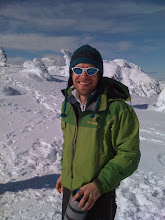I went to Chitina this weekend with some friends. We knew the fishing might not be good -- the dipnetting hotline said as much -- but we figured we might catch it before it got bad, or have a relaxed weekend and hit it when it got better, or maybe just power through and put in all the hours it took.
Now, even with hindsight, I'm not sure if we were foolish or just unlucky. As many times as I've gone to Chitina for dipnetting, there are some things I never learn, the largest of which is that it's impossible to have a pleasant weekend at Chitina. You can camp, with a car, but there are none of the luxuries of car camping. You're hiking, on a trail of sorts, but it's dusty and windy and you're carrying an awkward load. After we got skunked on Saturday, it simply did not seem worth it to hang out Sunday and try again Monday, despite the hundreds of miles we'd driven. Such is Chitina. You come, you fish, you go home -- whether you got your fish or not. Last year a friend and I caught 65 fish in 4 hours. This year we fished 10 hours and got one.
There are two main variables, it seems. First is the fish -- are they coming up the river? Are there lots, and are they passing the right spot at the right time? Second is the water level -- when the water rises too much, the fish stop moving upriver (even at low water, it's a wonder they can beat the current). One can monitor these variables with sonar and river gauges.
Then there are the gray areas, the art in place of science, the stories we create to explain the unknown. As we sat on the rocky bank, nets in the water, I imagined the fish moving upriver. (The water is so thick with glacial silt it's impossible to see anything under the surface.) I imagined them hugging the shore, slipping into eddies as they find them, following some chemical trail to their natal streams. I reached my net toward the eddy line, where the main current met the swirl of the eddy. Is the current less, the eddy stronger, at the bottom? I remembered a Native fisherman in Galena describing the narrow "trails" fish follow up the Yukon. Kings take one trail, chums another. Moving your fishwheel a few feet to one side can make all the difference. When Mark caught our one fish, I imagined it a forerunner. Then a straggler. Or maybe an independent fish that battled the current when others rested.
Other people invent theories, too. That silvers run at night. That the fish will start moving again when the shade reaches the right bank (that's how it worked for someone last year).
The week had been warm and sunny, and the water had been rising from snow and ice melt; one gauge measured 14 feet on Tuesday, 15 on Thursday, 16 Friday, and 17 Saturday. The fish seemed to stop moving sometime Saturday morning. When we arrived around midnight on Friday, we'd pitched a tent and slept 6 hours. (Scrambling on loose rock next to a raging river in near-dark seemed foolhardy.) The man who parked next to us had gone straight to fishing and had his limit by the time we woke up.
On Saturday, we watched the water rise hour-by-hour, moving up the bank as our perches became inundated. We knew some fishing spots were better than others at high water, and we figured the fish in the river had to go somewhere. From the trail, we looked down on a giant, slow eddy. People were fishing from a pair of boats. Maybe this is where the salmon rest. We crashed through alders to the eddy. Now there was one boat, drifting slowly upriver in the eddy, motoring back down, drifting again. The boat was close enough that we could talk easily with people on board. They were pulling in multiple fish on each pass.
I nearly ran back up to get my gear and down again to start fishing. We fished one hour, two hours. We moved spots. We tied our nets to rocks and logs. I waded in. And we caught nothing. Was the banana I ate for breakfast bad luck?
Subscribe to:
Post Comments (Atom)


No comments:
Post a Comment